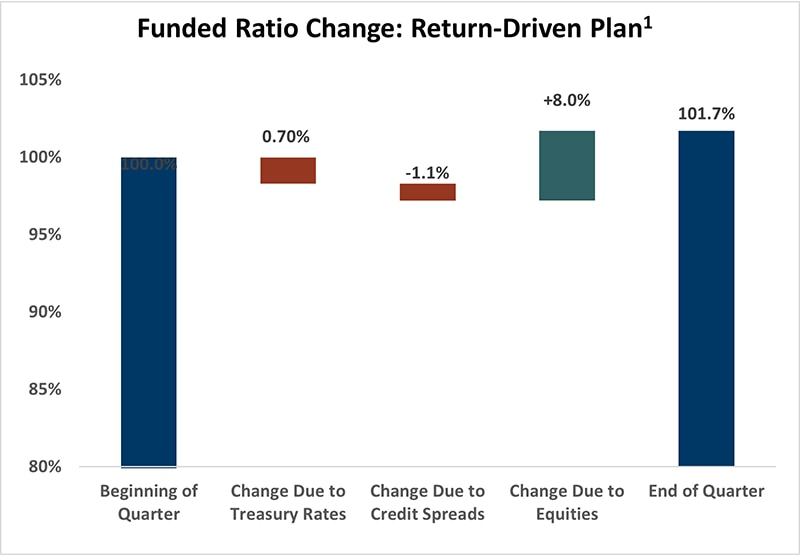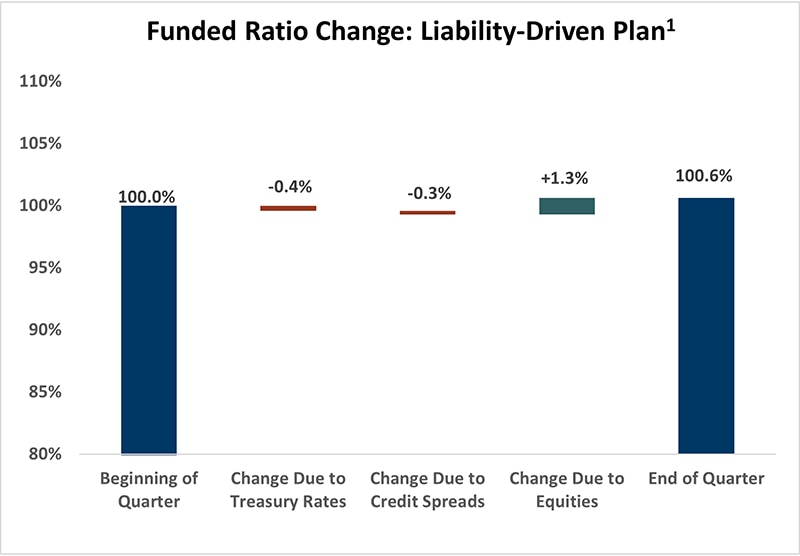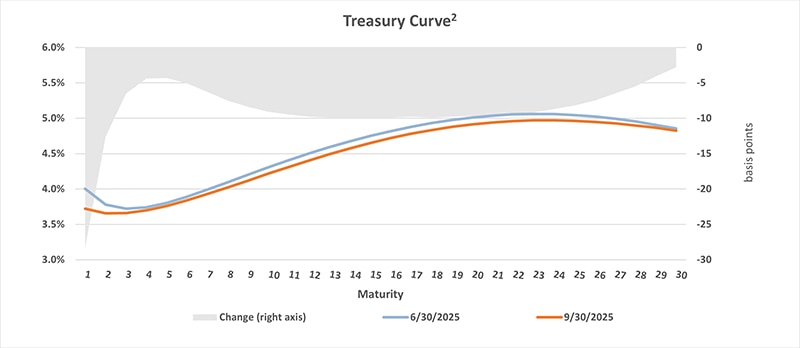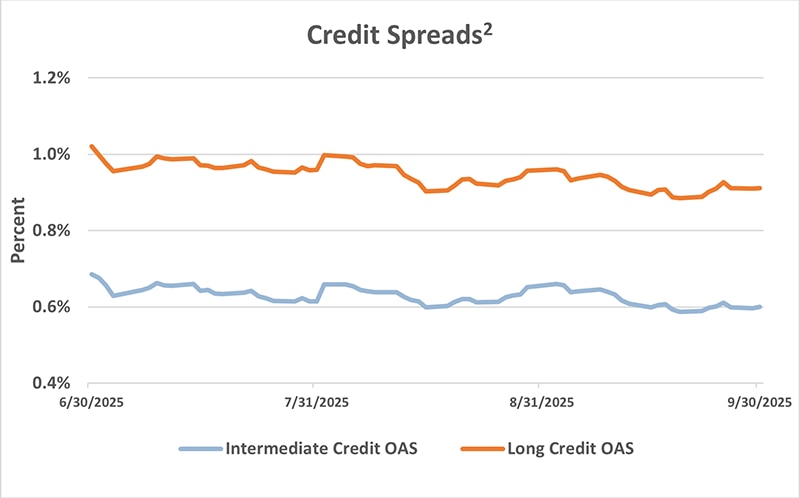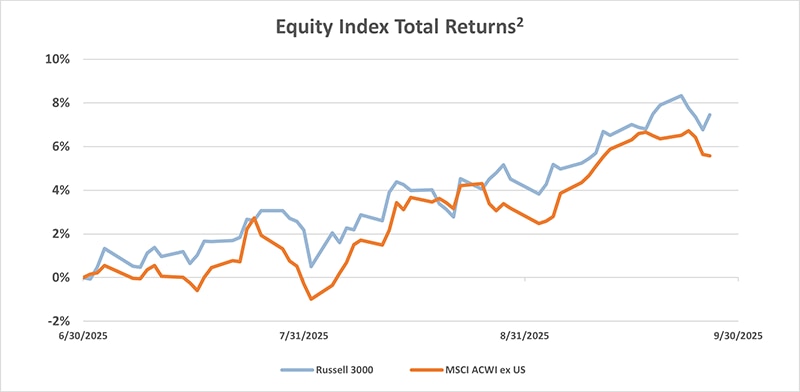
Corporate defined benefit plan funded levels increased during the third quarter of 2025. The primary drivers were positive returns in return-seeking asset classes. A typical return-driven plan had a 1.7% increase in its funded ratio, while a typical liability-driven plan observed a 0.6% increase. Return-driven plans with higher equity allocations saw a larger increase in funded status due to the larger impact of positive equity returns on the assets. Year to date, the sample return-driven plan funded ratio has increased approximately 6.7%, while the sample liability-driven plan funded ratio has increased approximately 2.2%.
Chart 1: Funded Ratio Change: Return-Driven Plan1
View accessible version of this chart.
Chart 2: Funded Ratio Change: Liability-Driven Plan1
View accessible version of this chart.
Treasury Rates
Treasury rates decreased and had a negative impact on funded status.
During the quarter, the Treasury curve continued to steepen with rates decreasing along the short end and the long end of the yield curve. The short end of the curve decreased approximately 4-28 basis points (bps), while the long end of the curve decreased more modestly, approximately 3-10 bps. The Federal Reserve reduced the federal funds rate by 25 bps in September, which directly impacted the short end of the curve. In isolation, the change in Treasury yields increased the liability and caused a decrease in funded ratios for return driven pension plans and a small decrease in funded ratios for liability driven plans.
Chart 3: Treasury Curve2
View accessible version of this chart.
Credit Spreads
Credit spreads narrowed and had a negative impact on funded status.
Narrowing credit spreads decreased the discount rates and increased liabilities. Intermediate duration credit spreads narrowed 8 bps while long duration credit spreads narrowed 11 bps. The overall decrease in spreads was driven by strong corporate fundamentals, resilient macroeconomic conditions and heightened investor demand for yield in a high-rate environment, which outpaced limited credit supply. On a net basis, considering decreasing Treasury yields, the total corporate bond discount rate for pensions decreased approximately 18 bps and increased plan liabilities..
Chart 4: Credit Spreads2
View accessible version of this chart.
Equities
Equity market performance had a positive impact on funded status.
Overall positive performance in global equity markets helped funded statuses this quarter, driven by a tech-led rally. Anticipated further Federal Reserve rate cuts and easing concerns over tariffs also contributed to the improvement. U.S. large cap stocks outperformed U.S. small cap stocks with returns of approximately 8.1% and 12.4%, respectively. International equities underperformed domestic equities and returned around 6.9%.
Chart 5: Equity Index Total Returns2
View accessible version of this chart.
1Assumptions
- Data as of 9/30/2025, Source: PNC.
- The funded ratio changes are for generic plans with allocation and liability profiles specified below. Results are market driven and do not incorporate any plan-specific effects, such as benefit payments, expenses, benefit accruals, or plan contributions. Funded ratio changes are sensitive to the beginning of the period funded ratio.
- A return-driven plan is a pension plan with an asset allocation commonly associated with an absolute return-objective and has a high allocation to return-seeking assets (public equity in this case) and typically has high funded status volatility. Assumed asset allocation is 70% MSCI All Country World, 30% Bloomberg Aggregate.
- A liability driven plan is one that is well along its path in a liability-centric approach to investing and has a large allocation to long-duration bonds to help reduce funded status volatility. Assumed asset allocation is 20% MSCI All Country World, 64% Bloomberg Long Credit, 16% Bloomberg Long Government.
- Liability profile is based on BAML Mature/Average U.S. Pension Plan AAA-A Corp Indexes with average duration of 13.1 years.
2Data as of 9/30/2025, Source FactSet®. FactSet® is a registered trademark of FactSet Research Systems Inc. and its affiliates.
Contact Us »
Accessible Version of Charts
Chart 1: Funded Ratio Change: Return-Driven Plan1
| Return-Driven Plan | Funded Ratio Change |
| Beginning of Quarter | 100.0% |
| Change due to Treasury Rates | 0.70% |
| Change Due to Credit Spreads | -1.1% |
| Change Due to Equities | 8.0% |
| End of Quarter | 101.7% |
Chart 2: Funded Ratio Change: Liability-Driven Plan1
| Liability-Driven Plan | Funded Ratio Change |
| Beginning of Quarter | 100% |
| Change due to Treasury Rates | -0.4% |
| Change Due to Credit Spreads | -0.3% |
| Change Due to Equities | 1.3% |
| End of Quarter | 100.6% |
Maturity |
6/30/25 |
9/30/25 |
Change (right axis) |
1 |
4.00% |
3.72% |
-0.28 |
3 |
3.72% |
3.66% |
-0.06 |
5 |
3.80% |
3.76% |
-0.04 |
7 |
3.99% |
3.93% |
-0.06 |
9 |
4.20% |
4.12% |
-0.08 |
11 |
4.41% |
4.31% |
-0.10 |
13 |
4.59% |
4.49% |
-0.10 |
15 |
4.75% |
4.65% |
-0.10 |
17 |
4.88% |
4.78% |
-0.10 |
19 |
4.98% |
4.88% |
-0.10 |
21 |
5.04% |
4.94% |
-0.10 |
23 |
5.06% |
4.97% |
-0.09 |
25 |
5.05% |
4.96% |
-0.23 |
27 |
4.99% |
4.93% |
-0.06 |
29 |
4.91% |
4.87% |
-0.04 |
Date |
Intermediate Credit Option-Adjusted (OAS) |
Long Credit Option-Adjusted Spread (OAS) |
6/30/25 |
0.69 |
1.02 |
7/31/25 |
0.61 |
0.96 |
8/31/25 |
0.65 |
0.96 |
9/30/25 |
0.60 |
0.91 |
Chart 5: Equity Index Total Returns
| Index | Date | Percent |
| Russell 3000 | 6/30/2025 | 0.00% |
| 7/31/2025 | 2.18% | |
| 8/31/2025 | 4.51% | |
| 9/30/2025 | 7.45% | |
| MSCI ACWI ex USA | 6/30/2025 | 0.00% |
| 7/31/2025 | -0.29% | |
| 8/31/2025 | 3.17% | |
| 9/30/2025 | 5.58% |

